Composting for Newbies
If you’re trying to lessen your negative environmental impact on the world, composting can help a great deal.
Living in the country and composting is easy. All you need is a place to throw your food scraps and any fallen leaves, sticks, and grass clippings to get a good balance of carbon and nitrogen.
In an urban environment, composting can be more complicated.
There are extra considerations like: unwelcome smells, vandalism, scavenging animals, neighbors, and landlords.
Here are a few terms, ideas to understand, and personal observations for the composting newbie.
What is compost?
Whether left as a pile in a field or contained within a sophisticated enclosure, the real magic happens in the collected waste. Bacteria, fungi, insects, and worms all work together through several decomposition phases to break down the organic material brought to their compost heap.
The difference between composting and throwing your waste away in the garbage is the amount of oxygen that can help break down the organic materials.
In landfills, organic material breaks down without oxygen. The bacteria that decompose these materials are anaerobic, they release more methane than their aerobic counterparts.
In compost, however, there is plenty of oxygen. The organisms that thrive in this environment are aerobic. As they break down the organic materials, the compost as-a-whole transitions from one phase to another. The waste products from the organisms in one phase help set the ideal conditions for the following phase.
Why compost?
-
Lessen your carbon footprint
Sending food scraps to a landfill produces methane. As above, composting allows aerobic organisms to thrive. As a result, those same food scraps generate more carbon dioxide than methane. By altering the output from a relatively strong greenhouse gas like methane to a weaker one like carbon dioxide, you can reduce your impact on the environment.
Additionally, every kilo of waste rerouted from landfills is a kilo that doesn’t need to be transported by heavy and fuel-inefficient garbage trucks. It seems like this is just a small thing until you start composting and realize that you only have to take out a small/light trash bag once every few weeks instead of weekly. And that the trash you do generate doesn’t smell bad.
Add this up for every household in your community. This seemingly small change starts to add up fast.
-
Make friends and build community
This is more true of urban composting than rural. At my neighborhood compost site, there are 2-3 dedicated times per week to drop off food scraps. This is limiting, especially if you miss a week, but the result is that you keep seeing the same faces again and again. It is a natural community incubator.
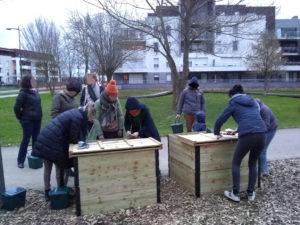
Plus, looking on as others add their food scraps allows everyone to engage with each other. You can say,
‘Hey, isn’t that an animal product? That will be smelly and attract animals. Let’s put it in the trash instead.’
People can’t pop in at midnight to deposit a big barrel of animal products or compost riddled with plastic leftovers from the store.
It’s also great for kids! Kids love to shovel the compost around to aerate the contents. Couple kids’ natural enthusiasm with tactile, educational content and you’ll quickly have a league of little composters. It is an easy and wholesome bonding moment!
I assure you, at any well-organized compost site there will always be something to talk about
-
Learn
Carbon, nitrogen, methane? This isn’t high-school chemistry class, but aside from reading labels on cleaning products when else do you get the chance to learn about chemistry? Composting also interlinks easily with other subjects like cooking, health, gardening, urban planning, and environmentalism.
Often I come home from my composting shift with questions to research, and I feel like a more engaged member of my community.
-
Improve the environment
Diverting methane-producing waste and lowering your carbon footprint is one side of the coin of improving the environment, not damaging it more than necessary. The other side comes from making a microenvironment that welcomes helpful bacteria, fungi, and pests. These form the base of the food pyramid and allow animals higher in the pyramid to thrive. For example, the birds that eat the insects that resproduce in and around the compost pile.
-
Harvest the rich compost at the end
A particular draw for gardeners! After your compost pile has gone through all its phases, you get well-balanced and nutritious soil. Take it and put it around your plants to make sure they get the nutrients they need.
How to Compost?
The TL;DR :
Gather your leftover foodstuffs, put them in a pile, mix dry materials like leaves and cardboard, and let them sit.
That’s not so complicated, is it?
For those who want a little more detail :
Generally, composting involves mixing materials rich in nitrogen with those rich in carbon. Think of your leftover foodstuffs as the source of nitrogen. The carbon comes from dry plant matter (leaves, wood chips, sticks, bamboo, etc.)
Among composters, we sometimes call nitrogen-rich materials ‘Greens,’ and carbon-rich ones ‘Browns.”
I was taught to add about one container of browns for each container of greens.
It can be tricky to get the perfect ratio, though. Foodstuffs (greens) can be full of water, so they’ll look large until they dry. Plant matter (browns) might take up a large volume of space (especially brush and sticks) but may be more modest in terms of mass.
Try to have wood chips, cardboard, paper, or dried leaves handy to rebalance if needed.
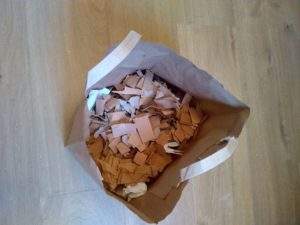
You’ll have to see what works for you.
If you live in a rural environment, feel free to bring your food scraps out whenever your compost container gets full or smells bad. You’ll probably have plenty of browns at your disposal already.
If you’re an urbanite, you may be more limited as to when you can deposit your compost container in the community compost pile. If you are worried about smells in the house, try to keep your container outside, keep it open and well aerated (though sheltered from the rain.) Or, if you prefer, you can keep your compostables in the freezer.
Outside of the summertime, smells haven’t been a problem for me with a once-weekly deposit at our neighborhood compost site.
Acquiring browns may need to be more deliberate. Collect any pure cellulose tissues, toilet paper rolls, egg cartons, and newspaper with organic ink. You can add these to your home container to absorb any excess juices.
Urban versus Rural Composting
Given the population density of urban environments, there are some additional considerations you’ll need to confront if you want to set up or participate in Urban Composting.
Unwelcome smells
Unwelcome smells mostly come from poorly calibrated compost piles. If the compost is too wet, it will start to stink. Animal products (meat, dairy, shells) or processed foods (cooked foods and oils) can also lead to bad smells. Most urban composters prohibit the addition of animal products.
Vandalism
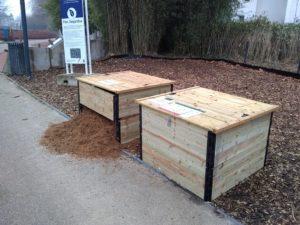
I’m not sure why some people try to open compost bins or why they may want to yank the enclosure apart. But, from my community composting experience, I’ve realized that there will always be a certain amount of petty vandalism near the compost bins. There are some actions that you can take, however, to limit the damage and frequency of this vandalism.
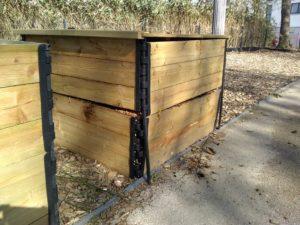
- Add a lock. I know this doesn’t seem very community-minded, but compost needs time to sit undisturbed. Vandals adding non-compostable materials or scattering the compost is hardly community-minded either.
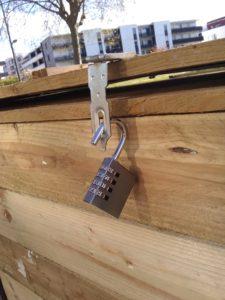
- Install a sturdy compost container. Something that isn’t so flimsy the next bored teenager who chances along will be able to open and desecrate with his/her bare hands.
- Install a fence. I think this is even less community-spirited than locking, but every community is different.
- Install signs. Why bother to open a curious box when you can just read the sign on its exterior? Most people are good if curious. Informing your neighbors about what’s inside the new compost bin will help them to accept it.
- Community engagement. Who would bother to vandalize their own compost bin? Even if your neighbor is not actively involved in composting themselves. If they know somebody who composts regularly, that neighbor will be less likely to vandalize this important part of community infrastructure.
Scavenging animals
I haven’t seen this as a problem where I live in France. It is probably because I live in a decently sized city with few wild places nearby. But in America, I know that compost can attract bears, skunks, and other animals sensitive to smell. To limit the number of animals who will scavenge in your pile for their dinner, again, consider limiting meat products.
Neighbors
Whether NIMBYs or fellow travelers, neighbors are something to consider. Most people want to see themselves as community-minded. Summon this goodwill and engage your neighbors! The more who want to help out, the better. Isn’t that the point? And the more who participate, the fewer will be those who inadvertently cause damage to the compost system.
Landlords/City Officials
This is a roll of the dice. Some landlords won’t mind if you compost in or around their property. Some are adamantly opposed. I suppose the rare landlord might encourage composting as well. City officials are more or less in the same camp about public spaces in their jurisdiction. If the composting system runs well and doesn’t demand time or resources from the authority figure he/she will accept it more easily.
Here is where composting organizations come into play. They can guarantee that compost sites will be well-maintained, and they can educate participants on how to compost. One of the biggest frustrations is how long it can take to set up a compost site on community land in your neighborhood.
More and more cities are adopting environmental objectives. These may correspond to community compost sites. It all depends on where you are.
Common Difficulties
-
Too wet
You guessed it. Add some more browns. Stir to aerate.
-
Too dry
Well, stop adding so many browns, then!
-
Vandalism
See above for some ideas about how to control this sort of problem.
-
Non-compostables contaminating the compost stream
In the country, this is easy to control. In a community compost, this may be more difficult to avoid. Again, focus on community. Hopefully, an organization will be doing classes in parallel with your group. And, of course, information about what not to put in your compost is available on the internet. You may have to raise questions or speak to your neighbors directly though. Probably the biggest problem is that people aren’t aware that what they are putting in the compost is a problem. Here is another reason to have fixed times and dates for dropping compost off. Everyone is under the eye of everyone else, and if anything needs to be discussed it is the right occasion.
What is your experience composting? Are you an urban composter? Any hints or tips to pass along?